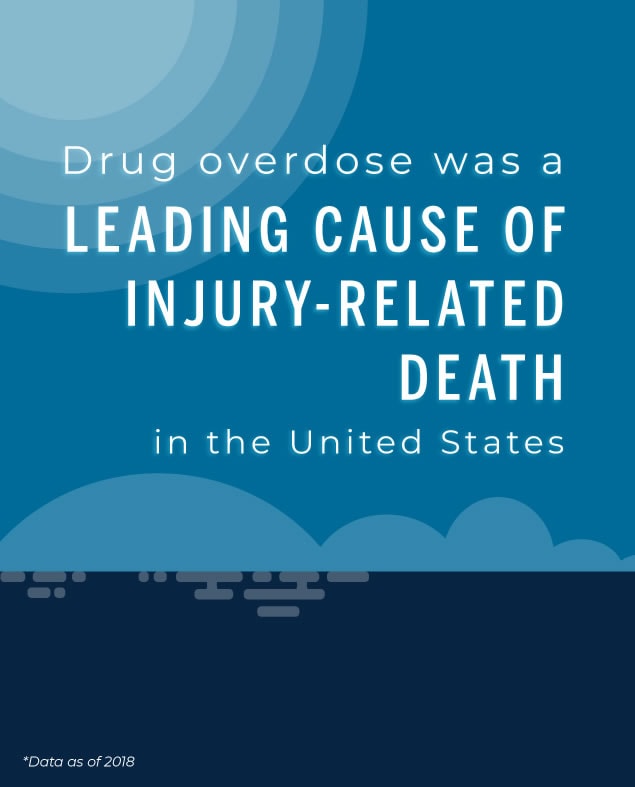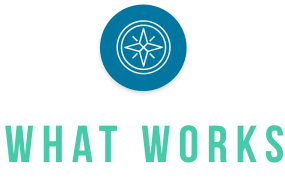Health Topics – Opioid Overdose

Economic Burden
The economic burden of opioid use disorder and fatal opioid overdose was estimated to be $1.02 trillion in 2017, with a majority of the costs attributed to reduced quality of life from opioid use disorder and the value of life lost due to fatal opioid overdose.
Overview
In 2018, more than 67,000 people died from drug overdoses, making it a leading cause of injury-related death in the United States. Of those deaths, almost 70% involved a prescription or illicit opioid. Drug overdose deaths continue to increase in the United States. As of December 2019, provisional data show that drug overdoses accounted for over 71,000 deaths.
From 1999–2018, almost 450,000 people died from an overdose involving any opioid, including prescription and illicit opioids. The first wave of overdose deaths began with increased prescribing of opioids in the 1990s, with overdose deaths involving prescription opioids (natural and semi-synthetic opioids and methadone) increasing since at least 1999. The second wave began in 2010, with rapid increases in overdose deaths involving heroin. The third wave began in 2013, with significant increases in overdose deaths involving synthetic opioids, particularly those involving illicitly manufactured fentanyl. The market for illicitly manufactured fentanyl continues to change, and it can be found in combination with heroin, counterfeit pills, and cocaine.
Prescription opioids can be addictive and dangerous. In fact, as many as one in four patients receiving long-term opioid therapy in a primary care setting struggles with opioid addiction. In 2018, 9.9 million Americans, ages 12 and older, reported misusing prescription opioids.
Living with pain: It is essential that patients and their doctors discuss treatment options, including those available for acute and chronic pain, with all of the risks and benefits carefully considered. Some medications, such as prescription opioids, can help relieve pain in the short term but also come with serious risks and potential complications—and must be prescribed and used carefully.
Risk Factors
People who take prescription opioids may be at higher risk of addiction or overdose if they:
Have a history of overdose or substance use disorder
Obtain drugs from multiple prescribers
Consume a high total daily dosage
Combine use of opioids with other drugs or alcohol
Initiate substance use in youth

Prescription Drug Monitoring Programs (PDMP)
A prescription drug monitoring program (PDMP) is an electronic database that tracks controlled substance prescriptions in a state. PDMPs can provide health authorities timely information about prescribing and patient behaviors that contribute to the epidemic and facilitate a nimble and targeted response.
PDMPs continue to be among the most promising state-level interventions to improve opioid prescribing, inform clinical practice, and protect patients at risk. States can consider ways to increase and maximize use of PDMPs.
CDC Guideline for Prescribing Opioids for Chronic Pain
The CDC Guideline for Prescribing Opioids for Chronic Pain provides recommendations for the prescribing of opioid pain medication for patients 18 and older in primary care settings. Recommendations focus on the use of opioids in treating chronic pain (pain lasting longer than 3 months or past the time of normal tissue healing) outside of active cancer treatment, palliative care, and end-of-life care. States can consider promoting and supporting the use of the CDC Guideline for Prescribing Opioids for Chronic Pain.
Medications for Opioid Use Disorder (MOUD)
Medications for Opioid Use Disorder (MOUD) is a comprehensive way to address the needs of individuals with opioid use disorder that combines the use of medication (methadone, buprenorphine, or naltrexone) with counseling and behavioral therapies. Opioid misuse can lead to addiction, which causes changes to the brain’s structure and functions. MOUD helps counteract these changes to the brain by blocking certain receptors in the brain and therefore plays a crucial role in controlling withdrawal symptoms as people try to manage their recovery. States can consider increasing access to substance abuse treatment services, including medications for opioid use disorder.
CDC’s National Center for Injury Prevention and Control is conducting a study of Medication Assisted Treatment (term that preceded MOUD) that examines how health and other patient outcomes vary across the three types of medications used in MAT and for patients receiving counseling only treatment. Patient, site, and provider characteristics will also be examined to determine how they may impact health and other outcomes.
Eliminating Prior-Authorization Requirements for Medications for Opioid Use Disorder
This strategy refers to health insurance providers covering the cost of medications for opioid use disorder as a standard benefit and removing all requirements that a physician contact the insurance provider for approval prior to writing the prescription (a process called “prior authorization”). Without these prior authorization requirements, prescriptions for medications to treat opioid use disorder can be written and filled as soon as a physician deems this treatment necessary, free from artificial delays. The strategy for removing prior authorization requirements works best when policy makers and healthcare providers work collaboratively with health insurance companies and state Medicaid programs to design and implement these policy changes.
Centers for Disease Control and Prevention. Evidence-Based Strategies for Preventing Opioid Overdose: What’s Working in the United States. National Center for Injury Prevention and Control, Centers for Disease Control and Prevention, U.S. Department of Health and Human Services, 2018.
Targeted Naloxone Distribution
Naloxone is an opioid antagonist that can quickly and safely reverse the potentially fatal effects of an opioid overdose. Targeted distribution programs seek to train and equip individuals who are most likely to encounter or witness an overdose—especially people who use drugs and first responders— with naloxone kits, which they can use in an emergency to save a life. There are many different approaches to distributing naloxone to people at high risk of experiencing or witnessing an overdose. Effective approaches include community distribution programs, co-prescription of naloxone, and equipping first responders. States can consider identifying opportunities to expand first responder access to naloxone, a drug used to reverse overdose.
Centers for Disease Control and Prevention. Evidence-Based Strategies for Preventing Opioid Overdose: What’s Working in the United States. National Center for Injury Prevention and Control, Centers for Disease Control and Prevention, U.S. Department of Health and Human Services, 2018.
Featured Resources
CDC is committed to preventing opioid misuse, overdose, and deaths. 5 key strategies guide our work and help us protect all Americans
The Second Annual Surveillance Report of Prescription and Illicit Drug-Related Risks and Outcomes covers latest data available on rates of opioid prescribing, substance use disorder, nonfatal hospitalizations and emergency department visits, and overdose deaths.
CDC’s Evidence-Based Strategies for Preventing Opioid Overdose: What’s Working in the United States
This publication is an introduction to 10 opioid overdose prevention strategies for community leaders, public health, law enforcement, local organizations, and others striving to serve their community.
State-level policies that enhance prescription drug monitoring programs (PDMPs) or regulate pain clinics have shown some promising results. This resource highlights the success of six states in implementing various prescription drug policies.
State Laws on Prescription Drug Misuse and Abuse
CDC’s Public Health Law Program and National Center for Injury Prevention and Control collaborated to create menus summarizing some of the legal strategies states have used to address prescription drug misuse, abuse, and overdose.
Featured Tools
It is important to identify and classify which types of drugs are involved in an overdose, how often they are involved, and how that involvement changes over time. By understanding drug involvement, we can better identify appropriate prevention and response activities. CDC uses a variety of data tools and resources to understand the scope of the drug overdose epidemic, both for overdose deaths and nonfatal overdoses treated in emergency departments or by emergency medical services.
Guideline Resources: Clinical Tools
These clinical tools were developed to help primary care providers carry out the complex task of balancing pain management with the potential risks that prescription opioids pose.
Guideline Resources: Interactive Training Series
This interactive online training series aims to help healthcare providers apply CDC’s recommendations in clinical settings through patient scenarios, videos, knowledge checks, tips, and resources. Providers can gain a better understanding of the recommendations, the risks and benefits of prescription opioids, nonopioid treatment options, patient communication, and risk mitigation. Each stand-alone module is self-paced and offers free continuing education.
Helpful Materials for Patients
This website provides information for patients about different ways to safely manage chronic and acute pain. It includes “Conversation Starter” tips for patients to initiate a discussion with their doctor about the risks and benefits of various pain management treatments.
CDC’s Rx Awareness campaign tells the stories of people whose lives have been impacted by prescription opioid misuse and overdose. The goals of the campaign are to increase awareness that prescription opioids can be addictive and dangerous and to reinforce that help is available for those suffering from an opioid use disorder. CDC’s Rx Awareness campaign offers a variety of materials and resources you can share.

